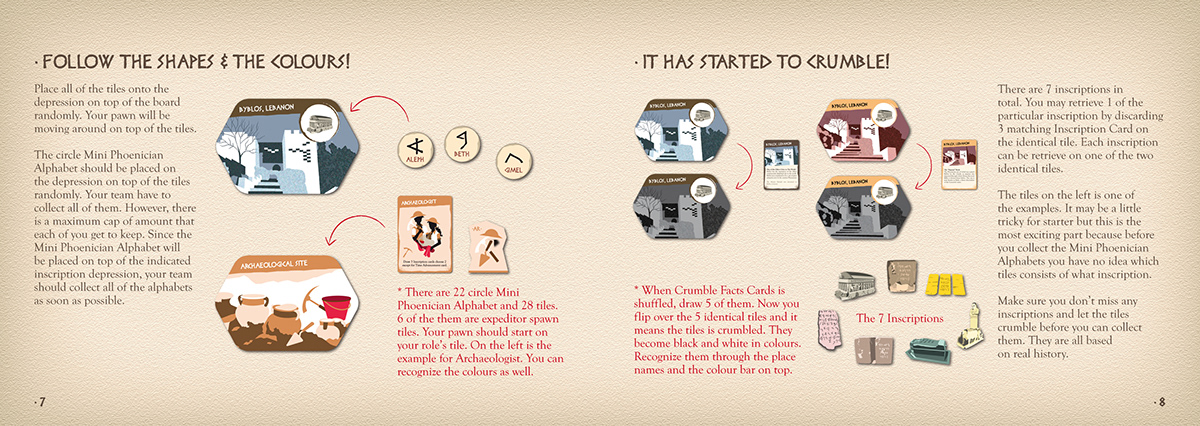Historical Educational Board Game
- The Lost 22
This is a personal board game project partially designed based on the game mechanic adapted from Forbidden Island, the latest creation by cooperative game master Matt Leacock. Additional new rules and extra features, plus the element of real historical facts has been infused into this with lots of research has been done. However, I would like to show my respect to game master Matt Leacock as my inspiration source for putting myself into the practice of board game making for the first time and be able to practice my visualizing skills at the same time.
The lost 22 is a historical educational board game designed to tell the story of the ancient civilization of the Phoenicia. This may be the first time you have heard of this mysterious sea people but nobody can deny they once exist and their contribution to the world. They are the least known important ancient civilization to the public yet they were the first state-level society to make extensive use of the alphabet.
The Phoenicians alphabet developed from the Proto-Canaanite alphabet, during the 15th century BC. They were the direct descendant of the Canaanites. The shapes of the alphabet can be traced back to the Egyptian hieroglyphic which is the parent script. The Phoenician alphabet was the first alphabetic script to be widely-used. The Phoenician phonetic alphabet is the ancestor of the modern alphabets - the Latin and the Arabic alphabet. Phoenician alphabet does not contain any vowels. It has only 22 alphabets.
The first traces of the Phoenician alphabet were discovered at Byblos, Lebanon. Its appearance dates between 1100 and 1050 BC. And this is where your “Alpha-Bet” comes from. The ‘Alpha’ and ‘Beta’ from Greek derived from the Phoenician alphabet ‘Aleph’ and ‘Beth’. It means ‘Ox’ and ‘House’ respectively and it is our Latin alphabet ‘A’ and ‘B’.
The lost 22 is a historical educational board game designed to tell the story of the ancient civilization of the Phoenicia. This may be the first time you have heard of this mysterious sea people but nobody can deny they once exist and their contribution to the world. They are the least known important ancient civilization to the public yet they were the first state-level society to make extensive use of the alphabet.
The Phoenicians alphabet developed from the Proto-Canaanite alphabet, during the 15th century BC. They were the direct descendant of the Canaanites. The shapes of the alphabet can be traced back to the Egyptian hieroglyphic which is the parent script. The Phoenician alphabet was the first alphabetic script to be widely-used. The Phoenician phonetic alphabet is the ancestor of the modern alphabets - the Latin and the Arabic alphabet. Phoenician alphabet does not contain any vowels. It has only 22 alphabets.
The first traces of the Phoenician alphabet were discovered at Byblos, Lebanon. Its appearance dates between 1100 and 1050 BC. And this is where your “Alpha-Bet” comes from. The ‘Alpha’ and ‘Beta’ from Greek derived from the Phoenician alphabet ‘Aleph’ and ‘Beth’. It means ‘Ox’ and ‘House’ respectively and it is our Latin alphabet ‘A’ and ‘B’.

The board game.
The packaging with specific compartment that fits every bits and pieces.

The set up for the game. It takes around 10-15 minutes.

Example of ongoing gameplay.

At the back of the board is the map of Mediterranean Sea. Player could learn about the location of the artefact and the geography of the countries.

Moving Pawn.

Some interesting facts on the card about the state/country.

Part of the Roman Alphabet evolution - Phoenician Alphabet.

The back of the board is the map of Mediterranean Sea.

Illustration of the artefacts and inscription indicates the location of it around the map for learning purposes.

Maximum 4 players but there are 6 jobs for player to select. They can choose to be Archeologist, Cartographer, Historian, Geographer, Conservator or Cryptologist. Each with different moves available to assist each other in order to complete the game.

Special card holder designed for the convenient of the player instead of leaving the stack of cards around while playing the game. Player can select the card and discard it on the front compartment of the card holder.

More facts about the artefacts and inscription that were discovered by the archeologist.

The symbols that matched the meaning of the Phoenician Alphabet. Players are to collect and do the matching.

Some spread examples in the rules guide for the board game - Page 7 - 8.

Page 9 - 10.








